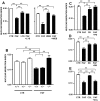Platelet activating factor blocks interkinetic nuclear migration in retinal progenitors through an arrest of the cell cycle at the S/G2 transition
- PMID: 21298035
- PMCID: PMC3029264
- DOI: 10.1371/journal.pone.0016058
Platelet activating factor blocks interkinetic nuclear migration in retinal progenitors through an arrest of the cell cycle at the S/G2 transition
Abstract
Nuclear migration is regulated by the LIS1 protein, which is the regulatory subunit of platelet activating factor (PAF) acetyl-hydrolase, an enzyme complex that inactivates the lipid mediator PAF. Among other functions, PAF modulates cell proliferation, but its effects upon mechanisms of the cell cycle are unknown. Here we show that PAF inhibited interkinetic nuclear migration (IKNM) in retinal proliferating progenitors. The lipid did not, however, affect the velocity of nuclear migration in cells that escaped IKNM blockade. The effect depended on the PAF receptor, Erk and p38 pathways and Chk1. PAF induced no cell death, nor a reduction in nucleotide incorporation, which rules out an intra-S checkpoint. Notwithstanding, the expected increase in cyclin B1 content during G2-phase was prevented in the proliferating cells. We conclude that PAF blocks interkinetic nuclear migration in retinal progenitor cells through an unusual arrest of the cell cycle at the transition from S to G2 phases. These data suggest the operation, in the developing retina, of a checkpoint that monitors the transition from S to G2 phases of the cell cycle.
Conflict of interest statement
Figures







Similar articles
-
Apical migration of nuclei during G2 is a prerequisite for all nuclear motion in zebrafish neuroepithelia.Development. 2011 Nov;138(22):5003-13. doi: 10.1242/dev.071522. Development. 2011. PMID: 22028032 Free PMC article.
-
Involvement of platelet-activating factor and LIS1 in neuronal migration.Eur J Neurosci. 2003 Aug;18(3):563-70. doi: 10.1046/j.1460-9568.2003.02778.x. Eur J Neurosci. 2003. PMID: 12911752
-
Platelet-activating factor is a downstream messenger of kainate-induced activation of mitogen-activated protein kinases in primary hippocampal neurons.J Neurosci Res. 1998 Aug 1;53(3):297-303. doi: 10.1002/(SICI)1097-4547(19980801)53:3<297::AID-JNR3>3.0.CO;2-5. J Neurosci Res. 1998. PMID: 9698157
-
Platelet-activating factor (PAF) receptor and genetically engineered PAF receptor mutant mice.Prog Lipid Res. 2000 Jan;39(1):41-82. doi: 10.1016/s0163-7827(99)00016-8. Prog Lipid Res. 2000. PMID: 10729607 Review.
-
Platelet-activating factor and related lipid mediators.Annu Rev Biochem. 2000;69:419-45. doi: 10.1146/annurev.biochem.69.1.419. Annu Rev Biochem. 2000. PMID: 10966465 Review.
Cited by
-
A measure of the broad substrate specificity of enzymes based on 'duplicate' catalytic residues.PLoS One. 2012;7(11):e49313. doi: 10.1371/journal.pone.0049313. Epub 2012 Nov 16. PLoS One. 2012. PMID: 23166637 Free PMC article.
-
Platelet-activating factor receptor (PAFR) regulates neuronal maturation and synaptic transmission during postnatal retinal development.Front Cell Neurosci. 2024 Mar 20;18:1343745. doi: 10.3389/fncel.2024.1343745. eCollection 2024. Front Cell Neurosci. 2024. PMID: 38572071 Free PMC article.
-
Lysophosphatidylcholine triggers cell differentiation in the protozoan parasite Herpetomonas samuelpessoai through the CK2 pathway.Acta Parasitol. 2020 Mar;65(1):108-117. doi: 10.2478/s11686-019-00135-8. Epub 2019 Oct 22. Acta Parasitol. 2020. PMID: 31755068
-
The terminal basal mitosis of chicken retinal Lim1 horizontal cells is not sensitive to cisplatin-induced cell cycle arrest.Cell Cycle. 2014;13(23):3698-706. doi: 10.4161/15384101.2014.964985. Cell Cycle. 2014. PMID: 25483080 Free PMC article.
-
The heterogenic final cell cycle of chicken retinal Lim1 horizontal cells is not regulated by the DNA damage response pathway.Cell Cycle. 2014;13(3):408-17. doi: 10.4161/cc.27200. Epub 2013 Nov 18. Cell Cycle. 2014. PMID: 24247150 Free PMC article.
References
-
- Boye E, Skjolberg HC, Grallert B. Checkpoint regulation of DNA replication. Methods Mol Biol. 2009;521:55–70. - PubMed
-
- Chow JP, Siu WY, Ho HT, Ma KH, Ho CC, et al. Differential contribution of inhibitory phosphorylation of CDC2 and CDK2 for unperturbed cell cycle control and DNA integrity checkpoints. J Biol Chem. 2003;278:40815–40828. - PubMed
Publication types
MeSH terms
Substances
LinkOut - more resources
Full Text Sources
Miscellaneous

